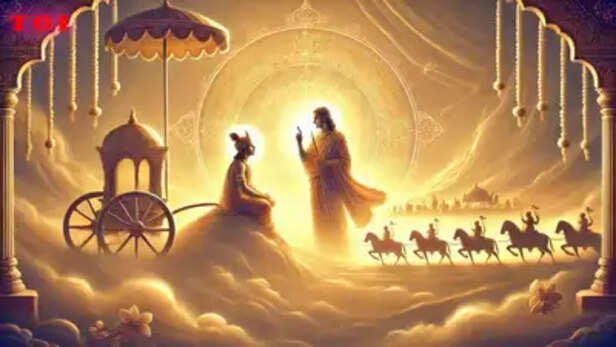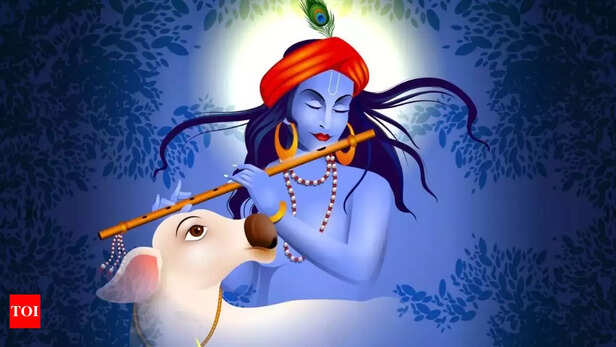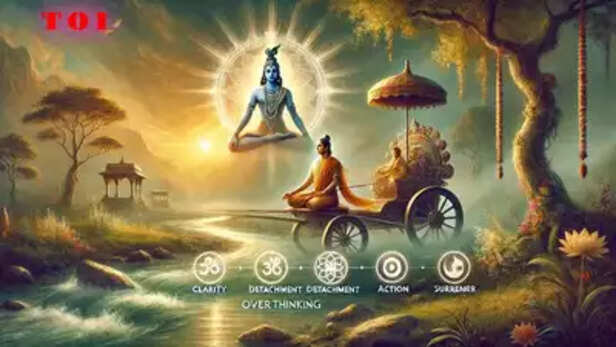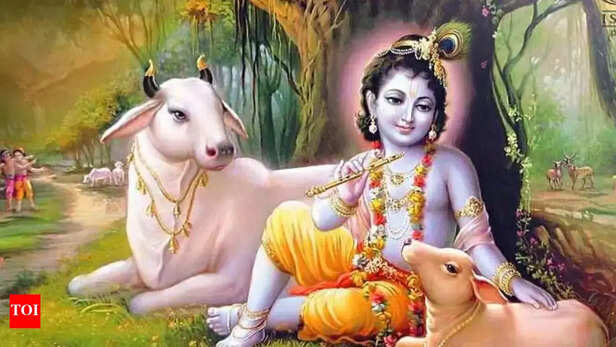What Most Devotees Don’t Know: The Hidden Difference Between Gita and Bhagavatam
Noopur Kumari | Apr 26, 2025, 17:15 IST
( Image credit : Times Life Bureau )
What if two of Hinduism’s most powerful scriptures—Bhagavad Gita and Shrimad Bhagavatam—were guiding your soul in completely different ways? One speaks of duty on the battlefield, the other sings of love in surrender. In this eye-opening article, we uncover the emotional, philosophical, and spiritual contrasts between these sacred texts. If you’ve ever wondered which path truly resonates with your soul, this read might just change your life.
The Bhagavad Gita and the Shrimad Bhagavatam stand out as everlasting sources of spiritual truth amidst the huge ocean of Hindu texts. They play distinct functions on the road to self-realization, despite the fact that they are frequently discussed simultaneously. The Bhagavad Gita provides intellectual and useful advice for facing moral conundrums head-on with bravery and clarity.
In the meantime, the devotional stories in the Shrimad Bhagavatam captivate the soul and demonstrate the exquisite beauty of love and submission to Lord Krishna. This essay explores the main distinctions between them, assisting readers in seeing how each text provides a unique yet complementary route to spiritual awakening, inner serenity, and purpose.

Set on the battlefield of Kurukshetra, the Bhagavad Gita is a potent 700-verse spiritual conversation between Lord Krishna and Arjuna that imparts eternal lessons on responsibility, life, and the self. It is included in the Bhishma Parva of the Mahabharata.
The Shrimad Bhagavatam, also known as the Bhagavata Purana, is a captivating 18,000-verse text that is divided into 12 cantos and is full of divine tales, particularly those that honor Lord Krishna's miracles and other Vishnu incarnations. The Bhagavatam captivates the spirit with devotion, heavenly play, and the essence of unadulterated love for God, while the Gita offers guidance through life's challenges.

A deep manual for living, the Bhagavad Gita teaches the fundamentals of dharma (duty), righteousness, and selfless deeds. It encourages us to act without regard for the outcome, guiding us through life's most difficult situations with courage and clarity.
The Shrimad Bhagavatam, on the other hand, transports readers to Lord Krishna's captivating hobbies and is a heavenly celebration of bhakti (devotion). It eloquently illustrates how spiritual emancipation can result from submitting to God and following the path of love and faith. One instructs on how to live, while the other teaches how to love.

In the succinct and potent Bhagavad Gita, Lord Krishna leads Arjuna through the most difficult issues in life, including duty, karma, and the way to emancipation. The 18,000-verse Shrimad Bhagavatam, on the other hand, is a magnificent tapestry full of captivating tales, sincere petitions, and moving parables.
It vividly depicts the splendour of Vishnu's avatars, Lord Krishna's playful leelas, and his close relationship with followers. The Bhagavatam warms the heart with unadulterated devotion and exquisite beauty, while the Gita enlightens the intellect.

An eternal manual for people looking for direction amid the chaos of life is the Bhagavad Gita. It teaches the art of selfless action, which is carrying out responsibilities without fear, ego, or attachment.
It serves as a guide to inner serenity and direction. The Shrimad Bhagavatam, on the other hand, is a holy voyage into the core of bhakti, or devotion and unwavering love for God. It awakens the soul's desire for a closer, more intimate relationship with the divine via captivating tales of Lord Krishna and His avatars. One leads with knowledge, while the other does so with affection.

The Shrimad Bhagavatam uplifts the soul with enthralling religious tales that deepen one's connection to the divine, while the Bhagavad Gita provides profound philosophical insight and helpful advice for leading a moral life. Despite their differences, both books are exquisitely complementary to one another. A person's spiritual journey would not be complete without the Gita, which reveals the path of wisdom, duty, and self-realization, and the Bhagavatam, which enchants with stories of divine love, miracles, and devotion. When combined, they offer a comprehensive strategy for leading a life filled with inner serenity, commitment, and purpose.

As Arjuna's charioteer and spiritual mentor, Lord Krishna excels in the Bhagavad Gita, conveying profound philosophical truths about life, responsibility, and the soul. He gives Arjuna the strength to overcome uncertainty and clearly accept his path. On the other hand, Krishna is portrayed in the Shrimad Bhagavatam as a charming lover, a mischievous child, and the Supreme Being, all of whom capture hearts with their devotional companionship and divine pastimes. Together, the Bhagavatam and the Gita present a comprehensive, moving picture of Krishna's eternal presence, while the Gita wakes the mind and the Bhagavatam melts the heart.Two shining lights on the road to spiritual enlightenment are the Bhagavad Gita and the Shrimad Bhagavatam, each of which imparts wisdom of its own. Through deep philosophical discussion, the Gita awakens the mind to dharma, karma, and self-realization. The Bhagavatam, on the other hand, is filled with appealing spiritual stories that use love and surrender to bring the soul closer to the divine. One addresses the seeker of activity and knowledge, while the other welcomes the heart-dedicate. When combined, they create a whole spiritual tapestry, where wisdom blossoms into devotion and intellect meets emotion.
Explore the latest trends and tips in Health & Fitness, Travel, Life Hacks, Fashion & Beauty, and Relationships at Times Life!
In the meantime, the devotional stories in the Shrimad Bhagavatam captivate the soul and demonstrate the exquisite beauty of love and submission to Lord Krishna. This essay explores the main distinctions between them, assisting readers in seeing how each text provides a unique yet complementary route to spiritual awakening, inner serenity, and purpose.
1. Origin and Structure

Bhagavata Purana
( Image credit : Times Life Bureau )
Set on the battlefield of Kurukshetra, the Bhagavad Gita is a potent 700-verse spiritual conversation between Lord Krishna and Arjuna that imparts eternal lessons on responsibility, life, and the self. It is included in the Bhishma Parva of the Mahabharata.
The Shrimad Bhagavatam, also known as the Bhagavata Purana, is a captivating 18,000-verse text that is divided into 12 cantos and is full of divine tales, particularly those that honor Lord Krishna's miracles and other Vishnu incarnations. The Bhagavatam captivates the spirit with devotion, heavenly play, and the essence of unadulterated love for God, while the Gita offers guidance through life's challenges.
2. Core Themes and Teachings

dharma
( Image credit : Times Life Bureau )
A deep manual for living, the Bhagavad Gita teaches the fundamentals of dharma (duty), righteousness, and selfless deeds. It encourages us to act without regard for the outcome, guiding us through life's most difficult situations with courage and clarity.
The Shrimad Bhagavatam, on the other hand, transports readers to Lord Krishna's captivating hobbies and is a heavenly celebration of bhakti (devotion). It eloquently illustrates how spiritual emancipation can result from submitting to God and following the path of love and faith. One instructs on how to live, while the other teaches how to love.
3. Narrative Style and Content

Shrimad Bhagavatam
( Image credit : Times Life Bureau )
In the succinct and potent Bhagavad Gita, Lord Krishna leads Arjuna through the most difficult issues in life, including duty, karma, and the way to emancipation. The 18,000-verse Shrimad Bhagavatam, on the other hand, is a magnificent tapestry full of captivating tales, sincere petitions, and moving parables.
It vividly depicts the splendour of Vishnu's avatars, Lord Krishna's playful leelas, and his close relationship with followers. The Bhagavatam warms the heart with unadulterated devotion and exquisite beauty, while the Gita enlightens the intellect.
4. Purpose and Application

Gita
( Image credit : Times Life Bureau )
An eternal manual for people looking for direction amid the chaos of life is the Bhagavad Gita. It teaches the art of selfless action, which is carrying out responsibilities without fear, ego, or attachment.
It serves as a guide to inner serenity and direction. The Shrimad Bhagavatam, on the other hand, is a holy voyage into the core of bhakti, or devotion and unwavering love for God. It awakens the soul's desire for a closer, more intimate relationship with the divine via captivating tales of Lord Krishna and His avatars. One leads with knowledge, while the other does so with affection.
5. Complementary Roles in Spiritual Practice

Roles in Spiritual Practice
( Image credit : Times Life Bureau )
The Shrimad Bhagavatam uplifts the soul with enthralling religious tales that deepen one's connection to the divine, while the Bhagavad Gita provides profound philosophical insight and helpful advice for leading a moral life. Despite their differences, both books are exquisitely complementary to one another. A person's spiritual journey would not be complete without the Gita, which reveals the path of wisdom, duty, and self-realization, and the Bhagavatam, which enchants with stories of divine love, miracles, and devotion. When combined, they offer a comprehensive strategy for leading a life filled with inner serenity, commitment, and purpose.
6. Role of Lord Krishna

Lord Krishna
( Image credit : Times Life Bureau )
As Arjuna's charioteer and spiritual mentor, Lord Krishna excels in the Bhagavad Gita, conveying profound philosophical truths about life, responsibility, and the soul. He gives Arjuna the strength to overcome uncertainty and clearly accept his path. On the other hand, Krishna is portrayed in the Shrimad Bhagavatam as a charming lover, a mischievous child, and the Supreme Being, all of whom capture hearts with their devotional companionship and divine pastimes. Together, the Bhagavatam and the Gita present a comprehensive, moving picture of Krishna's eternal presence, while the Gita wakes the mind and the Bhagavatam melts the heart.
Unveiling the Spiritual Giants of Hinduism
Explore the latest trends and tips in Health & Fitness, Travel, Life Hacks, Fashion & Beauty, and Relationships at Times Life!
